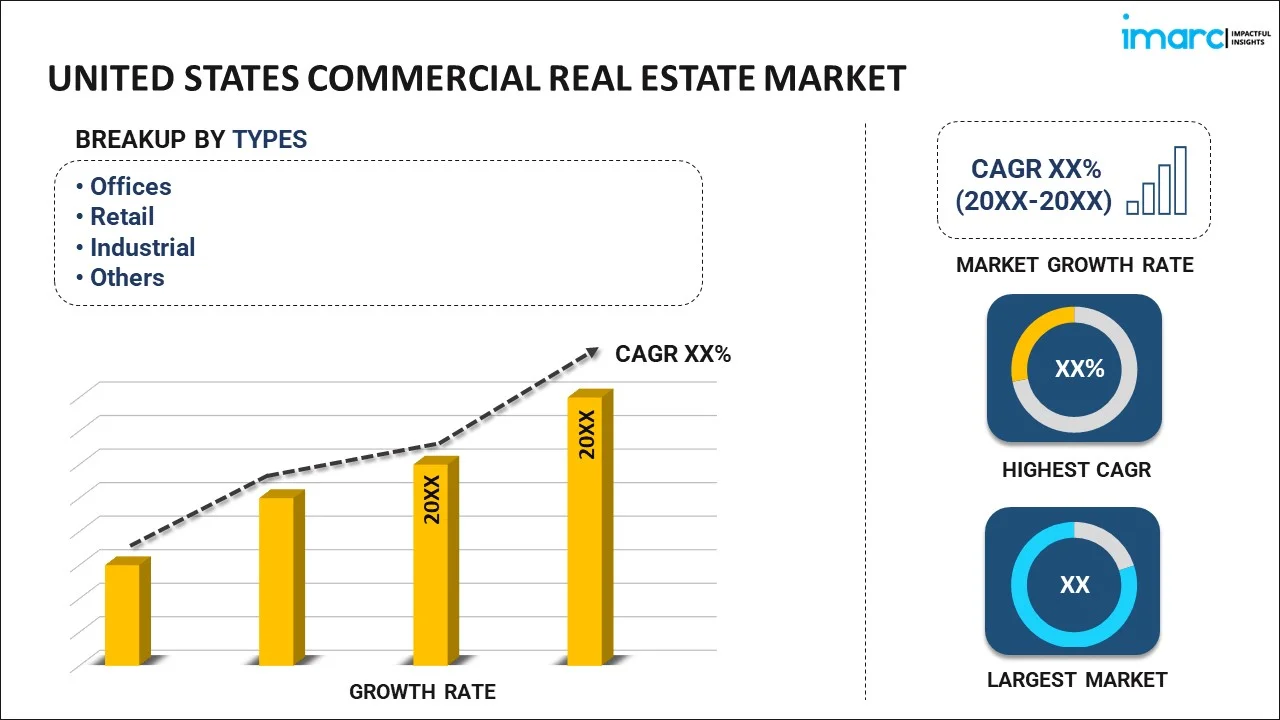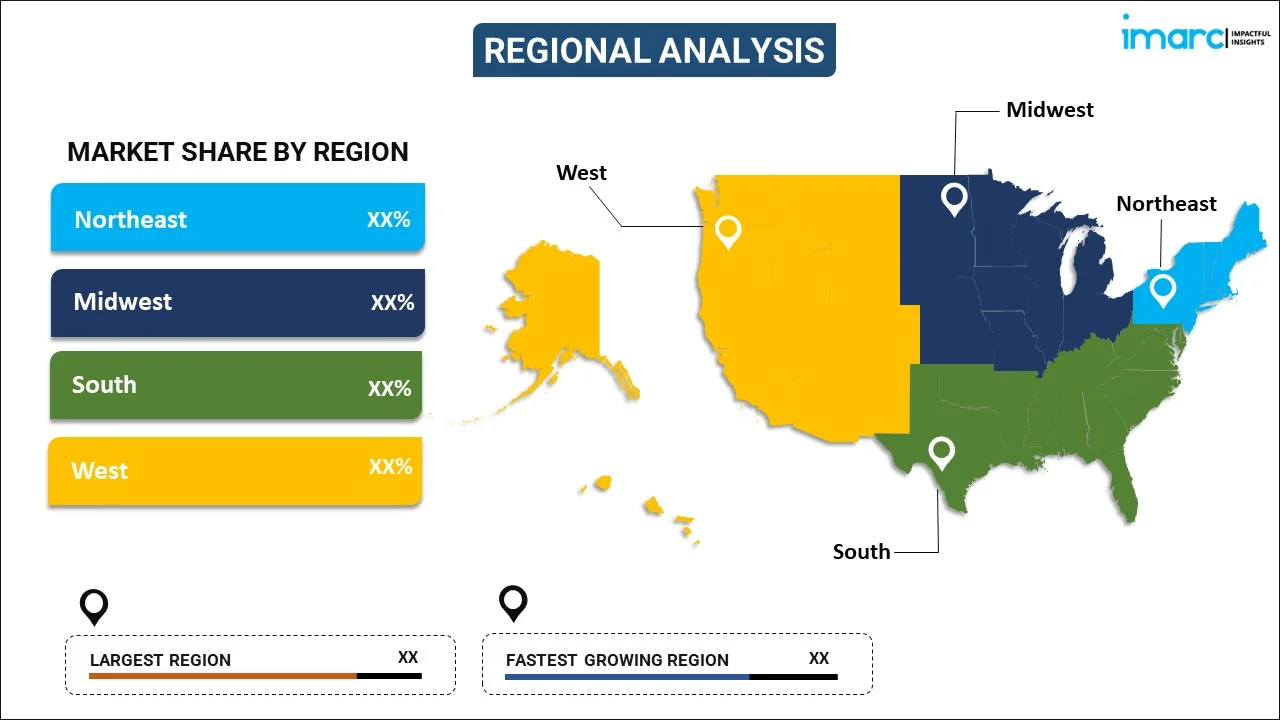
United States Commercial Real Estate Market Report by Type (Offices, Retail, Industrial, Logistics, Multi-Family, Hospitality), and Region 2025-2033
Market Overview:
United States commercial real estate market size reached USD 718.2 Billion in 2024. Looking forward, IMARC Group expects the market to reach USD 991.7 Billion by 2033, exhibiting a growth rate (CAGR) of 3.35% during 2025-2033. The increasing number of shopping centers, manufacturing plants, corporate headquarters, and logistics hubs, which is contributing significantly to the functionality and vibrancy of various industries, is primarily driving the market growth.
|
Report Attribute
|
Key Statistics
|
|---|---|
|
Base Year
|
2024
|
|
Forecast Years
|
2025-2033
|
|
Historical Years
|
2019-2024
|
|
Market Size in 2024
|
USD 718.2 Billion |
|
Market Forecast in 2033
|
USD 991.7 Billion |
| Market Growth Rate 2025-2033 | 3.35% |
Commercial real estate encompasses properties designated for business use, including offices, retail establishments, hotels, industrial facilities, and warehouses. In contrast to residential real estate, which primarily serves as living spaces, commercial properties are designed to generate income through rentals, leases, or sales. These properties serve as the infrastructure for a diverse array of business operations, including corporate offices, shopping complexes, manufacturing facilities, and logistics centers. The commercial real estate sector plays a crucial role in influencing the layout of urban areas and providing essential support to industries spanning various sectors.
United States Commercial Real Estate Market Trends:
The United States commercial real estate market stands as a cornerstone of the nation's economic landscape, comprising diverse properties utilized for business purposes. Ranging from office spaces and retail stores to hotels, industrial facilities, and warehouses, this market plays a pivotal role in shaping the urban and economic infrastructure. Additionally, in contrast to residential real estate, commercial properties are strategically designed to generate income through rentals, leases, or sales, forming the foundation for a myriad of business activities, which is acting as another significant growth-inducing factor. Besides this, the dynamics of the U.S. commercial real estate market reflect the nation's economic health and resilience, thereby positively influencing the regional market. Moreover, it responds to evolving business needs, demographic shifts, and technological advancements, making it a barometer of economic trends. As cities continue to evolve and businesses adapt to changing landscapes, the commercial real estate sector remains integral to the nation's growth and development. From iconic skyscrapers in urban centers to expansive industrial complexes, the U.S. commercial real estate market showcases a diverse and dynamic landscape that mirrors the multifaceted nature of the American economy. Furthermore, the emergence of intelligent buildings is also catalyzing the market growth across the country. These structures seamlessly incorporate digital systems to manage energy, enhance security, and provide convenience for occupants, which is anticipated to fuel the regional market over the forecasted period.
United States Commercial Real Estate Market Segmentation:
IMARC Group provides an analysis of the key trends in each segment of the market, along with forecasts at the country level for 2025-2033. Our report has categorized the market based on type.
Type Insights:

- Offices
- Retail
- Industrial
- Logistics
- Multi-Family
- Hospitality
The report has provided a detailed breakup and analysis of the market based on the type. This includes offices, retail, industrial, logistics, multi-family, and hospitality.
Regional Insights:

- Northeast
- Midwest
- South
- West
The report has also provided a comprehensive analysis of all the major regional markets, which include Northeast, Midwest, South, and West.
Competitive Landscape:
The market research report has also provided a comprehensive analysis of the competitive landscape in the market. Competitive analysis such as market structure, key player positioning, top winning strategies, competitive dashboard, and company evaluation quadrant has been covered in the report. Also, detailed profiles of all major companies have been provided.
United States Commercial Real Estate Market Report Coverage:
| Report Features | Details |
|---|---|
| Base Year of the Analysis | 2024 |
| Historical Period | 2019-2024 |
| Forecast Period | 2025-2033 |
| Units | Billion USD |
| Scope of the Report | Exploration of Historical and Forecast Trends, Industry Catalysts and Challenges, Segment-Wise Historical and Predictive Market Assessment:
|
| Types Covered | Offices, Retail, Industrial, Logistics, Multi-Family, Hospitality |
| Regions Covered | Northeast, Midwest, South, West |
| Customization Scope | 10% Free Customization |
| Post-Sale Analyst Support | 10-12 Weeks |
| Delivery Format | PDF and Excel through Email (We can also provide the editable version of the report in PPT/Word format on special request) |
Key Questions Answered in This Report:
- How has the United States commercial real estate market performed so far and how will it perform in the coming years?
- What has been the impact of COVID-19 on the United States commercial real estate market?
- What is the breakup of the United States commercial real estate market on the basis of type?
- What are the various stages in the value chain of the United States commercial real estate market?
- What are the key driving factors and challenges in the United States commercial real estate?
- What is the structure of the United States commercial real estate market and who are the key players?
- What is the degree of competition in the United States commercial real estate market?
Key Benefits for Stakeholders:
- IMARC’s industry report offers a comprehensive quantitative analysis of various market segments, historical and current market trends, market forecasts, and dynamics of the United States commercial real estate market from 2019-2033.
- The research report provides the latest information on the market drivers, challenges, and opportunities in the United States commercial real estate market.
- Porter's five forces analysis assist stakeholders in assessing the impact of new entrants, competitive rivalry, supplier power, buyer power, and the threat of substitution. It helps stakeholders to analyze the level of competition within the United States commercial real estate industry and its attractiveness.
- Competitive landscape allows stakeholders to understand their competitive environment and provides an insight into the current positions of key players in the market.
Need more help?
- Speak to our experienced analysts for insights on the current market scenarios.
- Include additional segments and countries to customize the report as per your requirement.
- Gain an unparalleled competitive advantage in your domain by understanding how to utilize the report and positively impacting your operations and revenue.
- For further assistance, please connect with our analysts.
 Inquire Before Buying
Inquire Before Buying
 Speak to an Analyst
Speak to an Analyst
 Request Brochure
Request Brochure
 Request Customization
Request Customization




.webp)




.webp)












